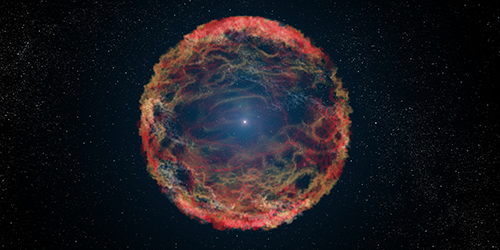Gaining a Multimessenger View of Supernovae Explosions
Massive stars die with a bang, exploding in a blaze of light, leaving behind a neutron star—an object that is among the densest in the Universe. Cosmically, these “core-collapse supernovae” (CCSNe) events are not rare. But in our Galaxy, they occur only once every 100 years. So when the next local one happens, scientists want to extract as much information from it as they can. Now Zidu Lin of the University of Tennessee, Knoxville, and colleagues propose a multimessenger approach to monitoring CCSNe that would allow scientists to validate models of a shock phenomenon that occurs just before the star explodes [1].
When a star exhausts its fusion fuel, it can no longer resist its own gravity. It has seconds to live. In the headlong collapse that ensues, the star’s matter becomes so hot—a billion kelvin—that it emits gamma rays. The gamma rays rip apart nuclei, whose protons combine with electrons to form neutrons, releasing a deluge of neutrinos. The compaction stops when the core becomes so dense that contraction cannot continue. The shrinking of the core slows, stops, and then reverses direction. This rebound of the core generates a shock wave. If the process were spherically symmetric, it would not produce any gravitational waves. But models indicate a high degree of asymmetry.
Lin and his colleagues recognized that the details of how the shock wave develops would manifest in gravitational-wave and neutrino signals emitted during the star’s death throes. Could those signals be detected from the next CCSN in our Galaxy? Yes, they conclude, but distinguishing between shock-wave models will take a combined analysis of data from both channels. The traditional single-messenger method is insufficient, Lin says.
–Katherine Wright
Katherine Wright is the Deputy Editor of Physics Magazine.
References
- Z. Lin et al., “Characterizing a supernova’s standing accretion shock instability with neutrinos and gravitational waves,” Phys. Rev. D 107, 083017 (2023).




